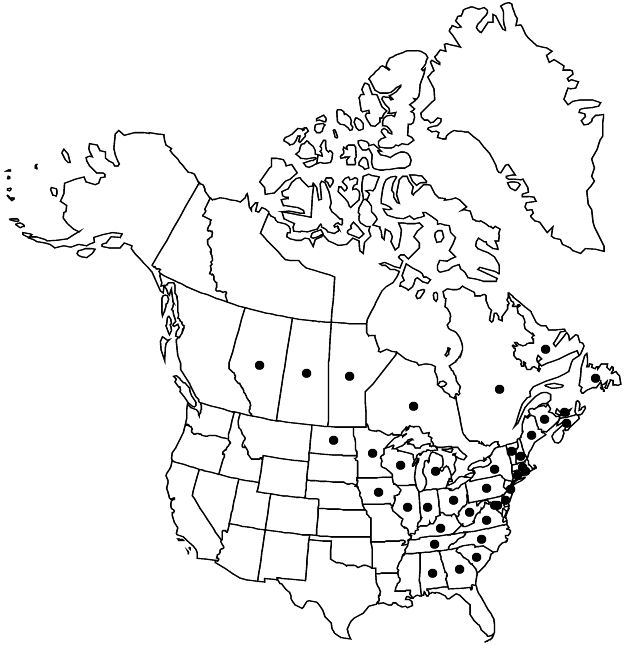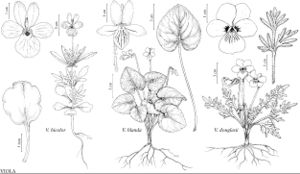Difference between revisions of "Viola blanda"
Hort. Berol. 1(2): plate 24. 1804.
FNA>Volume Importer |
imported>Volume Importer |
||
| (3 intermediate revisions by 2 users not shown) | |||
| Line 13: | Line 13: | ||
}}{{Treatment/ID/Special_status | }}{{Treatment/ID/Special_status | ||
|code=F | |code=F | ||
| − | |label= | + | |label=Illustrated |
}} | }} | ||
|basionyms= | |basionyms= | ||
| Line 19: | Line 19: | ||
|name=Viola blanda var. palustriformis | |name=Viola blanda var. palustriformis | ||
|authority=A. Gray | |authority=A. Gray | ||
| + | |rank=variety | ||
}} {{Treatment/ID/Synonym | }} {{Treatment/ID/Synonym | ||
|name=V. incognita | |name=V. incognita | ||
|authority=G. Don | |authority=G. Don | ||
| + | |rank=species | ||
}} {{Treatment/ID/Synonym | }} {{Treatment/ID/Synonym | ||
|name=V. incognita var. forbesii | |name=V. incognita var. forbesii | ||
|authority=Brainerd | |authority=Brainerd | ||
| + | |rank=variety | ||
}} {{Treatment/ID/Synonym | }} {{Treatment/ID/Synonym | ||
|name=V. leconteana | |name=V. leconteana | ||
| − | |authority= | + | |authority= |
| + | |rank=species | ||
}} | }} | ||
|hierarchy=Violaceae;Viola;Viola blanda | |hierarchy=Violaceae;Viola;Viola blanda | ||
| Line 55: | Line 59: | ||
-->{{#Taxon: | -->{{#Taxon: | ||
name=Viola blanda | name=Viola blanda | ||
| − | |||
|authority=Willdenow | |authority=Willdenow | ||
|rank=species | |rank=species | ||
| Line 69: | Line 72: | ||
|publication title=Hort. Berol. | |publication title=Hort. Berol. | ||
|publication year=1804 | |publication year=1804 | ||
| − | |special status=Endemic; | + | |special status=Endemic;Illustrated |
| − | |source xml=https:// | + | |source xml=https://bitbucket.org/aafc-mbb/fna-data-curation/src/2e0870ddd59836b60bcf96646a41e87ea5a5943a/coarse_grained_fna_xml/V6/V6_204.xml |
|genus=Viola | |genus=Viola | ||
|species=Viola blanda | |species=Viola blanda | ||
Latest revision as of 22:19, 5 November 2020
Plants perennial, acaulescent, stoloniferous, 3–20 cm; stolons pale, often rooting and leafy at nodes; rhizome short, slender, fleshy. Leaves basal, 2–9, prostrate to ascending; stipules linear-lanceolate, margins entire, apex acute; petiole 2–11 cm, usually sparsely pubescent; blade unlobed, reniform to ovate, 2–4 × 2–4 cm, base cordate, lobes often overlapping, margins serrate, ciliate or eciliate, apex rounded or acute to acuminate, surfaces sometimes glabrous, usually sparsely pubescent adaxially. Peduncles 3–11 cm, glabrous or pubescent. Flowers: sepals lanceolate to ovate, margins mostly eciliate, auricles 1–2 mm; petals white on both surfaces, lower 3 purple-veined, lateral 2 usually beardless, lowest 8–10 mm, spur white, gibbous, 1–2 mm; style head beardless; cleistogamous flowers axillary. Capsules ovoid to ellipsoid, 4–6 mm, glabrous. Seeds beige to bronze, 1.5–2 mm. 2n = 44, 48.
Phenology: Flowering Apr–Jun.
Habitat: Rich woods
Elevation: 30–2000 m
Distribution

Alta., Man., N.B., Nfld. and Labr., N.S., Ont., P.E.I., Que., Sask., Ala., Conn., Del., D.C., Ga., Ill., Ind., Iowa, Ky., Maine, Md., Mass., Mich., Minn., N.H., N.J., N.Y., N.C., N.Dak., Ohio, Pa., R.I., S.C., Tenn., Vt., Va., W.Va., Wis.
Discussion
Viola blanda occurs in small colonies; individual plants are interconnected by stolons.
Whether to recognize Viola incognita at any taxonomic level is currently unresolved. It is said to have pubescent
leaf blades, greenish peduncles, nontwisted lateral petals, and a preference for moister habitats. Most of these characters fall within the range of variation observed in V. blanda.
N. H. Russell (1965) noted that Viola incognita is principally found in glaciated areas whereas V. blanda is found in nonglaciated areas. Á. Löve and D. Löve (1982b) and J. M. Canne (1987) reported a chromosome count of 2n = 44; J. Clausen (1929) and A. Gershoy (1934) reported 2n = 48. V. B. Baird (1942) reported that V. blanda (and V. incognita) have fragrant flowers.
Selected References
None.
